Magura MT7 HC3 Brakes
Blister’s Measured Weight: 282 and 282 g (uncut hoses, no adapters or rotors)
MSRP: $329 per brake, w/o rotors or adapters
Bolted to: Nicolai G1, Guerrilla Gravity Trail Pistol, Starling Murmur
Reviewer: 6’, 170 lbs / 183 cm, 77.1 kg
Test Locations: Washington
Test Duration: 6 months
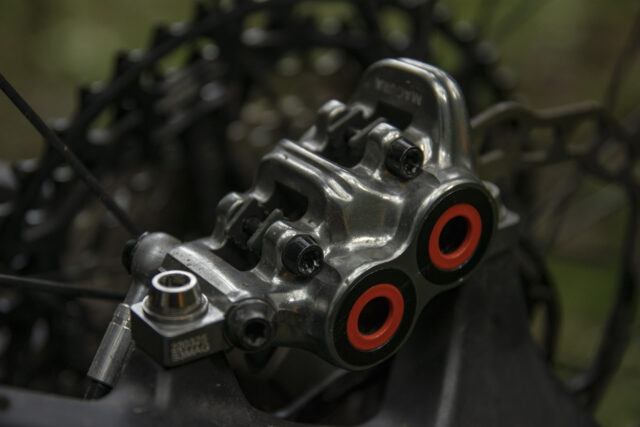
Intro
Magura has been in business for more than 125 years and started making hydraulic bike brakes in the 1980s — long before they were commonplace. The MT7 HC3 is their flagship gravity brake, and in a world where there are more good, DH-worthy brakes than ever before, the MT7s still manage to do a lot of things differently from the rest of the field.
Design
The MT7s are a four-piston brake with equally-sized 17 mm pistons. The caliper is a one-piece forged affair with a rotating banjo fitting, and the system runs on mineral oil. So far, so normal. But things get a lot more interesting at the lever end. For starters, the main body of the lever is made of fiber-reinforced plastic. It’s a flip-flop design, to be run on either side of the handlebar, and uses a two-bolt split clamp for attachment. Said screws thread directly into the master cylinder body, and use a much coarser thread for better purchase in the softer material than the typical machine screws used in metal-on-metal applications.
Magura also offers a range of lever blades for the MT7, and the HC3 version, tested here, has some tricks up its sleeve as well. The HC3 lever — designed with input from Danny MacAskill — features adjustable reach and free stroke adjustment (both require a tool) and while those adjustments are fairly typical for a high-end brake, the way that both work is less conventional.
Let’s start with the reach adjustment: unlike most brakes, which adjust reach by varying the starting position of the lever about the main pivot, the HC3 lever keeps the inboard portion of the lever fixed, and includes a second pivot point in the middle of the lever blade to handle the reach adjustment. A 3 mm Allen key on the face of the lever blade adjusts the initial position of the outboard portion of the lever blade, and while there’s a fair bit of adjustment range available, it’s a little narrower than some other brakes and is biased toward running the lever relatively close to the bar. The lever blade itself is notably thin and svelte but features an especially deep hook for secure one-finger braking close to the bar.
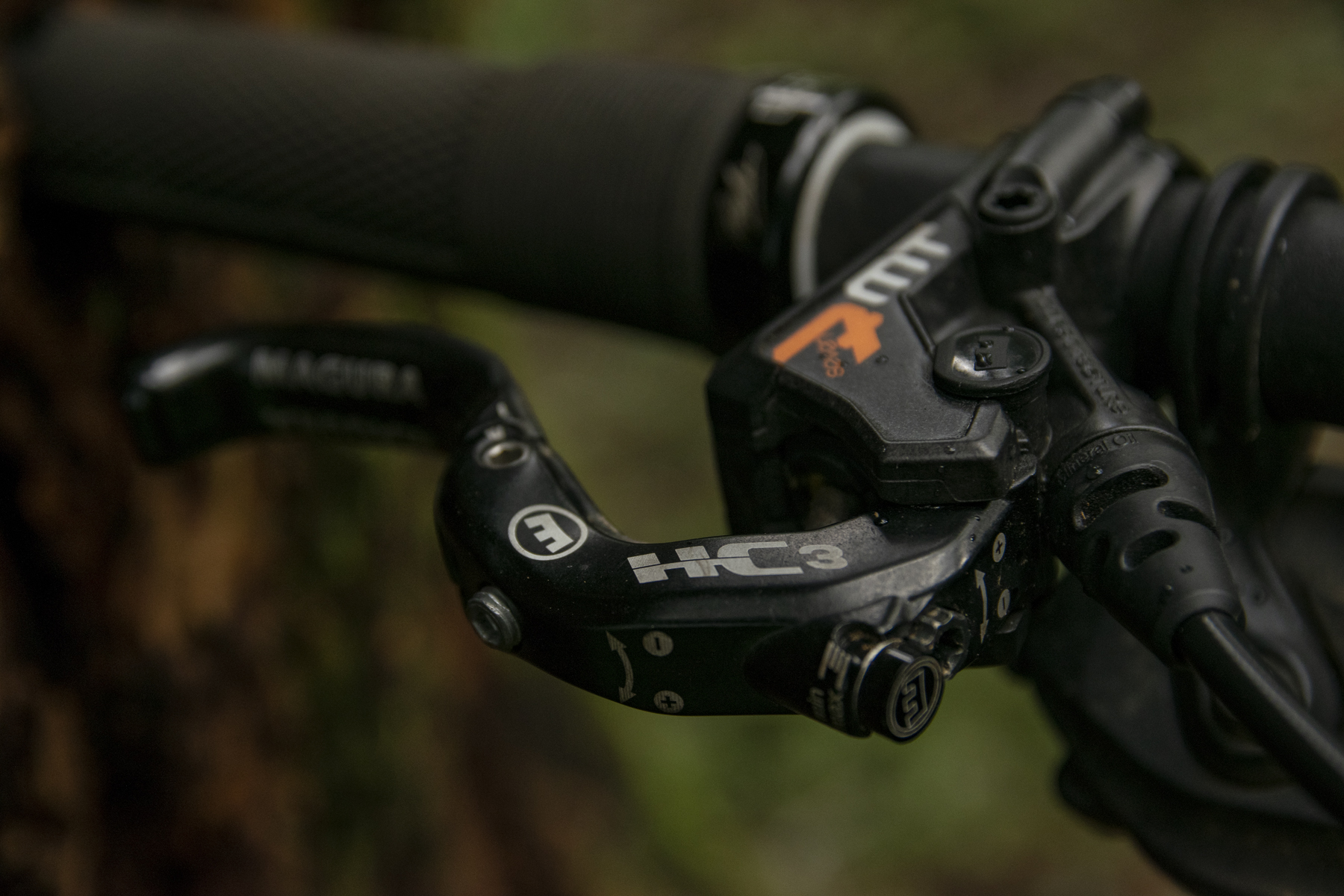
The reason for the unconventional reach adjustment is to make way for the unique bite point adjuster — which, unlike the vast majority of such adjustments out there, doesn’t just add some dead free stroke at the beginning of the lever throw. Before we go deeper into how the adjuster on the HC3 lever works, it’d probably be useful to do a quick rundown on how most contact point adjusters work to illustrate the contrast. And since I already covered the topic in my review of the Hayes Dominion A4 brakes a while back, I’ll just quote that here:
Modern hydraulic disc brakes for bikes operate on a semi-open system, meaning that the lever features a reservoir of “extra” hydraulic fluid that’s connected to the brake line when the lever isn’t being squeezed. This allows them, in part, to compensate for things like pad wear and thermal expansion of the brake fluid, as well as having a greater volume of brake fluid available to better transfer heat out of the system. When you squeeze the brake lever, the lever piston moves past the hole connecting this reservoir to the brake line (called the “timing port”) and closes it off. Only once the timing port is closed does the brake start to move fluid through the hose to the caliper, and build pressure to provide braking force. You can see the timing port of the A4 in the cutaway image below — it’s the little, tapered hole at the edge of the lever seal (black) in the bottom right corner.
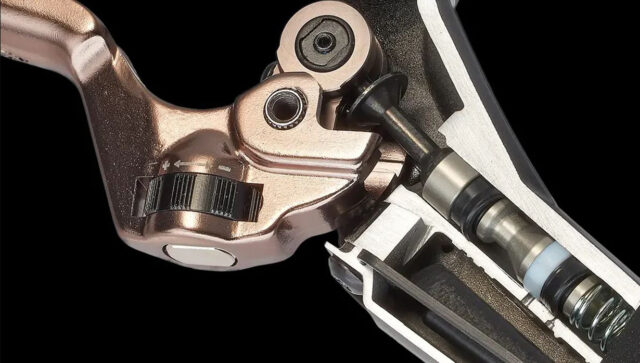
Contact-point adjusters work by changing the distance between the seal and the timing port when the lever is at its resting point (i.e. not being squeezed). Of course, they can’t move the seal past the timing port, or the brakes wouldn’t operate properly — they can only open up a gap between the two. What that means is that contact-point adjusters create a section of the stroke where the brake doesn’t do anything. Until the timing port is closed off, all that squeezing of the lever does is push fluid back into the reservoir in the lever, rather than down the line and to the caliper, since it follows the path of least resistance.
But while that’s all true for every other bite point adjuster that I’m aware of, it’s not in the case of the HC3 lever. Because (quite cleverly, in my opinion), that adjuster instead varies the mechanical advantage of the lever blade itself, by moving the pushrod that actuates the master cylinder relative to the main pivot point of the lever. The closer the pushrod is to the pivot, the greater the mechanical advantage the lever has, and therefore the longer the stroke is, and the softer the bite point; moving the pushrod out makes for a shorter stroke and firmer bite point.
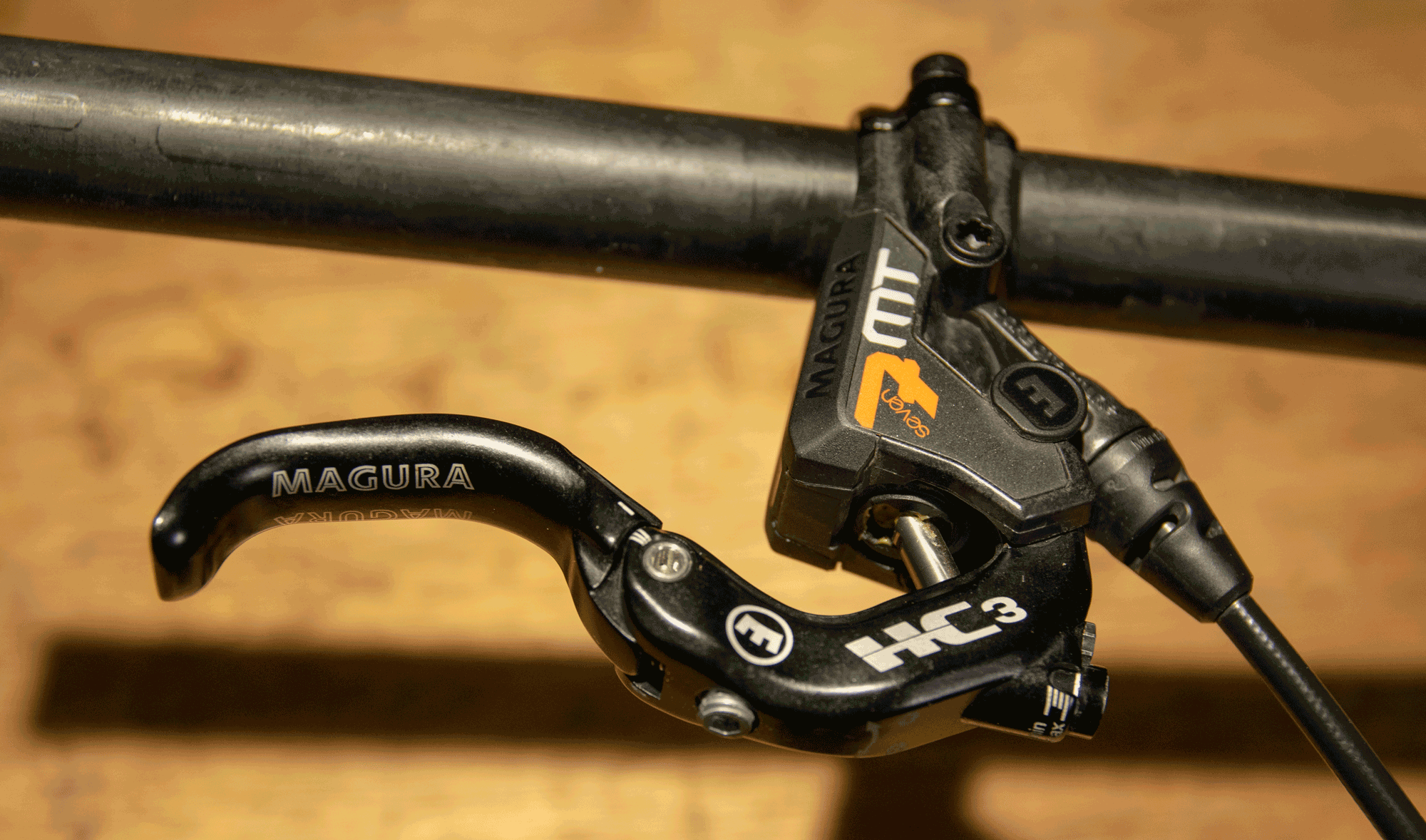
Of course, that also means that there’s a power difference across the range of settings — more mechanical advantage also means more braking power for a given force applied to the lever. That does mean that there’s a tradeoff in terms of outright power if you want to give the HC3 lever a shorter stroke / firmer bite point, but that’s just true of the tradeoffs that exist in designing a brake in general (check out Ep.122 of Bikes & Big Ideas with Hope engineer Sam Gibbs for a whole lot more on that). And by making a fundamentally different adjuster, I’d argue that Magura has made the feature far more useful than it is on most brakes, especially big, powerful gravity-oriented options that have generally long free strokes already (again, due to the inherent tradeoffs needed to make a brake have more mechanical advantage and therefore more power).
All that said, Magura does offer other lever blade options for the MT7 brakes, which are available both on new brakes from the factory as well as aftermarket, if you find yourself wanting to experiment. We’ve only tried the HC3 lever thus far, but Magura has a nice guide on their website that lays out the different options.
And while it’s maybe not as novel as the lever end of the MT7 HC3, the one-piece forged caliper does have a few unusual features, too. For starters, the MT7 uses four brake pads per caliper — one for each piston, instead of the more conventional one per side, with a large pad spanning a pair of pistons. And instead of using springs to retract the pads and keep them in contact with the pistons, Magura uses a small magnet embedded in the face of the piston to stick to the steel backing plate on the brake pads. Magura’s argument for the split pad arrangement is that it helps with cooling by allowing some airflow between the two pads on a given side of the caliper, though that line of thinking seems a little suspect given that most of the space is taken up by the pad guides and a bridge connecting the two sides of the caliper. It does stand to reason that the extra bridge would likely help stiffen the caliper for a firmer bite point though.
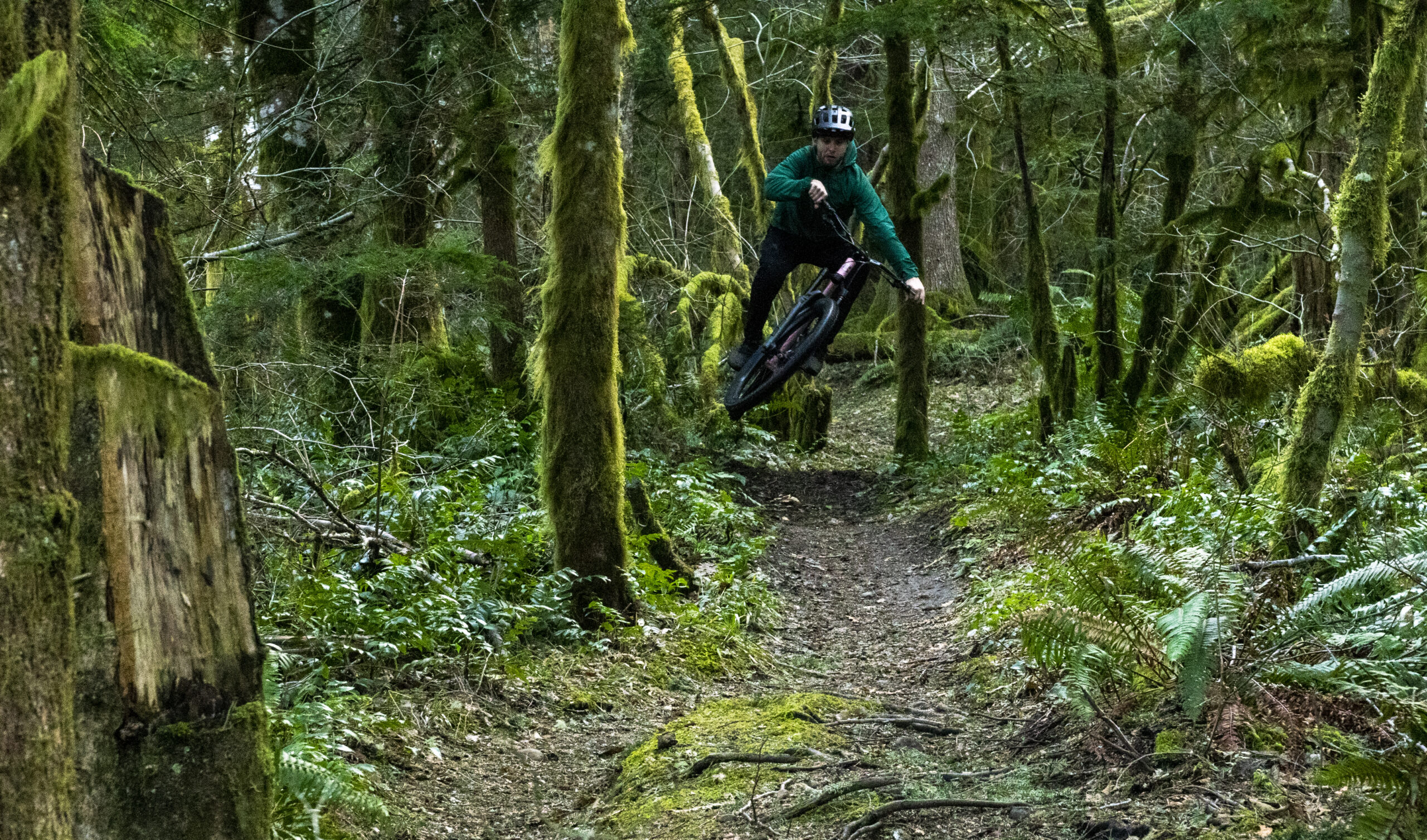
Magura uses T25 Torx heads for most of the fasteners on the MT7s, including the caliper and lever fixing bolts, the pad retaining screws, the bleed ports, and the power / free stroke adjuster on the HC3 lever. The lever end bleed plugs (there are two on each lever so that one’s always oriented up no matter which side of the bar you’re running it on) are made of plastic and while I’ve personally had no issues thus far, I’ve heard a number of reports of people stripping them due to the combination of soft material and beefy T25 interface. The torque spec on the lever plugs is 0.5 Nm (4 in-lb) — which is to say, almost nothing — so take it easy on those.
In addition to the standard clamps for mounting the MT7 levers, Magura offers a number of “Shiftmix” options for combining your other controls into the brake lever clamp. I haven’t tried any of the Shimano versions, but have used the SRAM one and found its adjustment range to be lacking. I tend to run my brake levers notably flat, and there’s simply not enough angle adjustment on the shifter position to get it to a comfortable place for my preferred brake lever location.
[The Shiftmix 3 effectively uses SRAM’s older Matchmaker standard, rather than the newer Matchmaker X that’s featured on their own higher-end brakes. I can make the latter work for me, but still prefer separate clamps in general, and the Magura / SRAM combo is especially limiting.]
On the Trail
Okay, that’s a lot of words about the design and layout of the MT7s. But how do they actually work?
Right off the bat, one of the most standout things about the MT7 HC3s is the lever feel. Even with the power / leverage adjuster set to the most powerful end of the range — where I preferred to run it, as we’ll go into more detail below — the bite point is relatively firm and the free stroke of the lever notably short; moving the leverage adjuster toward the other end of the range only makes it more so. And as advertised, the shape of the HC3 lever is excellent for running with the reach set in close to the bar. Some brakes, even ones that can accommodate a pretty short reach (SRAM Codes being a good example) can feel like the hook on the end of the lever blade loses its efficacy at the shorter end of the reach range, since the lever winds up angled in toward the bar at the shorter end of the reach range. The especially deep hook on the HC3 lever mitigates that nicely.
That said, the HC3 lever isn’t just for people who want to run a very short reach. The adjustment range covers what I’d describe as “very short” to “moderately long” reach; folks who prefer their levers quite far out might prefer one of Magura’s other lever blade options (or a different brake entirely) but I think the range of the HC3 lever will work for a whole lot of riders.
Personally, I love the shape of the HC3 lever in terms of its top-down profile but would prefer a slightly thicker, chunkier cross-section to give a bigger contact area between my finger and the lever blade. That’s 100% personal preference, though, and if you’d prefer a slimmer lever blade, it’s one of the better options out there.
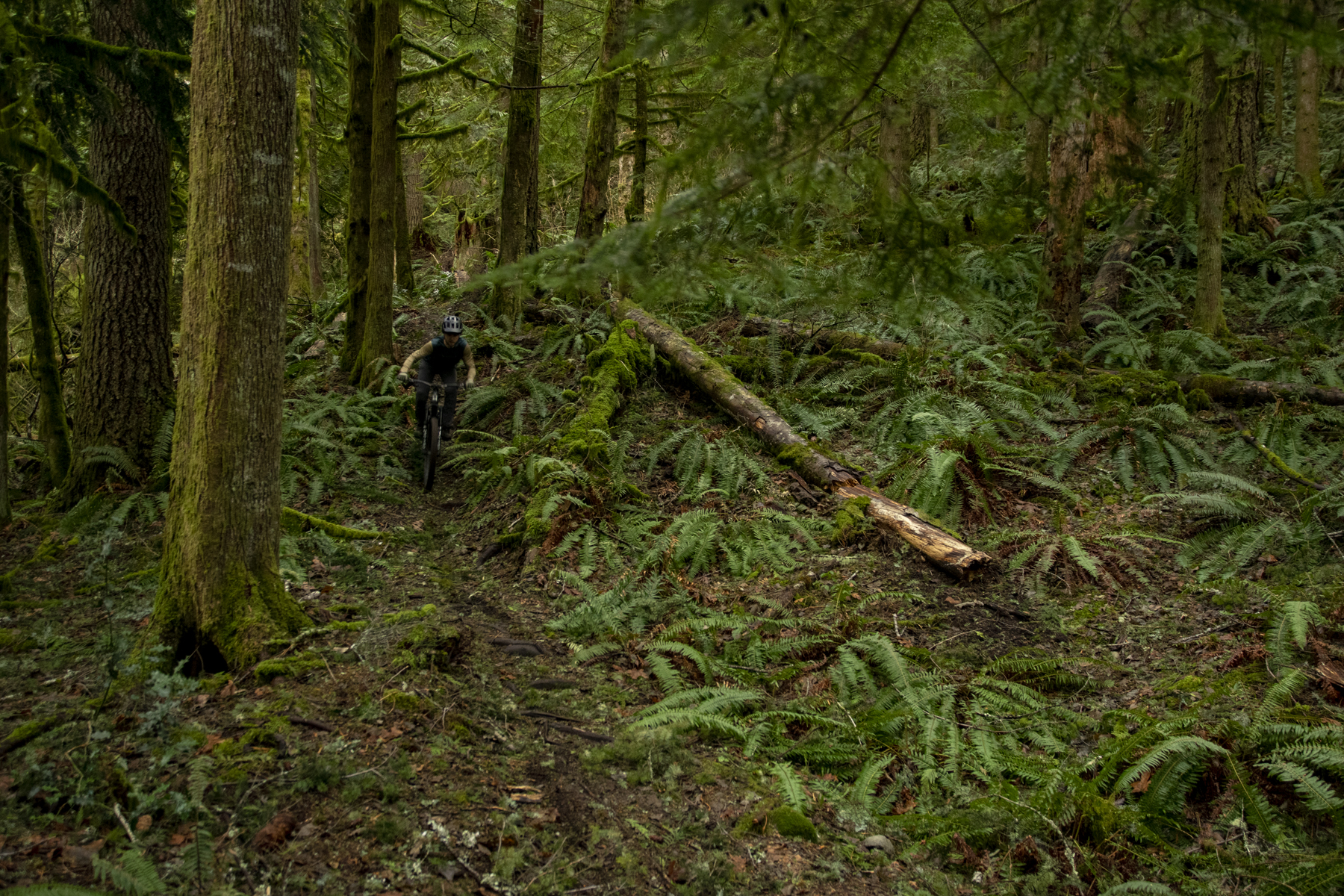
In terms of outright power, the MT7s are respectable, but not the outright strongest DH-ready brake on the market, by some margin. They’re in a similar ballpark to SRAM Code RSCs, but less powerful than Shimano XT 4-pistons or TRP DH-R Evos, and well off Hayes Dominion A4s, Hope Tech 4 V4s, and Cascade Components North Forks. That’s still pretty solid — we’re talking about most of the burliest DH brakes on the market here — but especially as 29ers have become more commonplace, people are riding harder and faster than ever before, and bikes with a whole bunch of motor and battery weight are becoming a big thing, it’s worth noting.
In my case, I rarely felt like I needed more power than the MT7s with dual 203 mm rotors could offer in any one specific instant, but did need to drag them for longer on some extended steep sections, which in turn gave me more frequent issues with overheating and fading than I’ve had with most of the other brakes mentioned in the prior paragraph. Rotor and pad selection of course factors in there as well — more on those below — but in general, heat management on the MT7s isn’t quite as good as a lot of their competitors.
To be clear, it would take a couple thousand feet’s worth of steep descending, at speed, for me to notice appreciable fading, and it’s not like I ever cooked the MT7s to the point of failure, or anything all that close to it. I’ve just been able to make them heat up to the point of losing a little power somewhat more readily than with the most powerful options out there.
For a lot of riders in a lot of places, I don’t think that’ll be a problem at all. As we say so often around here, it’s important to know thyself and be honest about what your wants and needs really are. The MT7s are still powerful brakes in the grand scheme of things, and especially if you want a brake that’s got a shorter throw and firmer bite point than the very most powerful brakes out there — remember, more power tends to make for longer throws and softer bite points — the MT7s are worth considering.
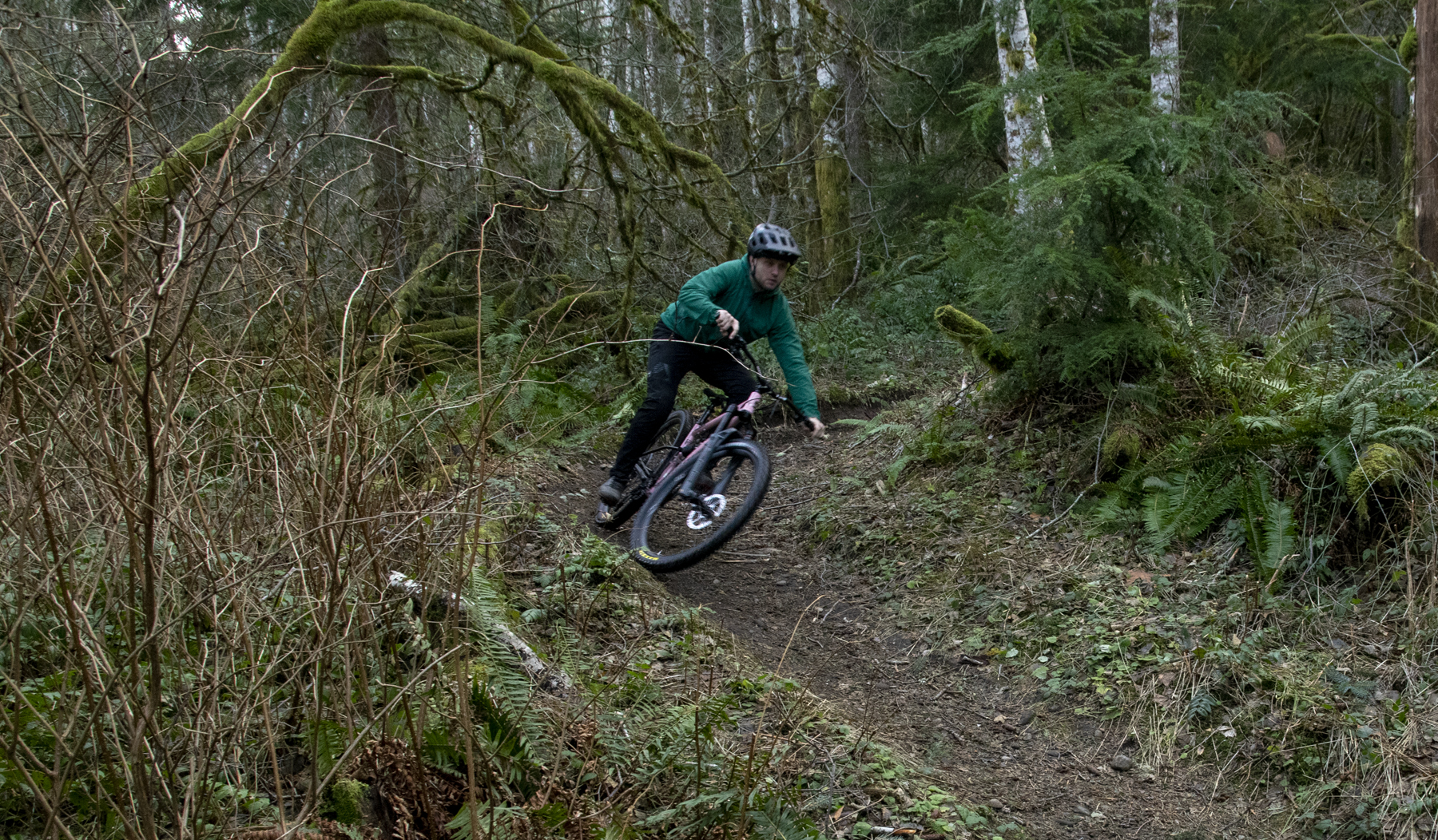
Brake Pads
Magura offers three different brake pads for the MT7s, dubbed “Race,” “Performance,” and “Sport”. The Performance pads come installed stock in the MT7s, but I’ve tried the Race and Sport pads as well. In short, I think Magura’s comparison chart has things about right. The Race pads have significantly more braking power than either of the other two in the dry, but fall off significantly in the wet; they’re also easier to get to fade than the other two options and aren’t particularly durable. The Sport pads are quiet and hard-wearing but offer less overall power in most conditions.
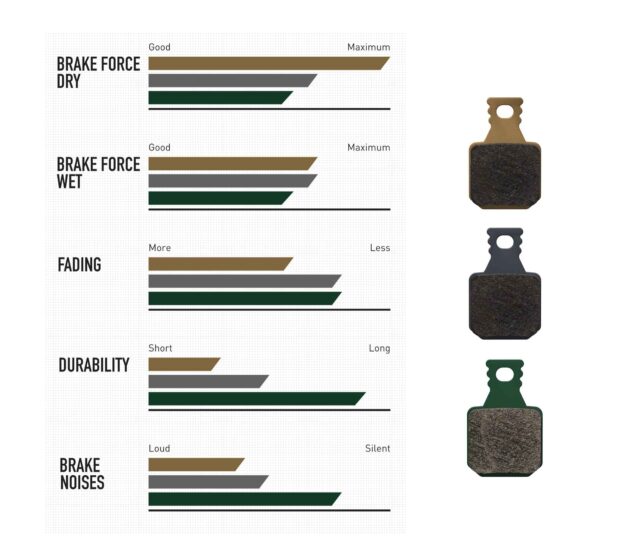
Rotors & Rotor Sizes
Magura offers a number of different rotor designs, many of which come in both six-bolt and centerlock configurations, and I initially started my testing with their standard Storm HC rotors, in a 203 mm size both front and rear. And for the most part, those worked pretty well. They were true out of the box and were quiet, smooth, and generally solid performing.
That said, their heat dissipation isn’t the best. Depending on where and how you ride, that might not be an issue at all, but on some longer, steeper descents, I noticed significant fading in terms of brake power, and with it, clear discoloration and signs of heating in the rotors.
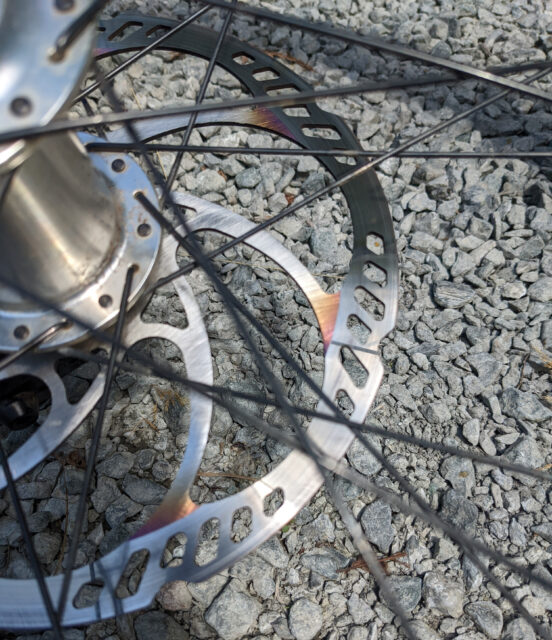
Given the discoloration pattern and the geometry of the rotors, my hunch is that the arms connecting the braking track to the center of the rotor are just too few in number and too thin where they meet the braking track to conduct heat out of the braking track as effectively as they might. And so my next step was to try Magura’s beefier MDR-C rotors, which feature both more connecting arms and more material where those arms meet the braking track — and indeed, that extra material made a real difference in heat dissipation. The MDR-C rotors do come with a weight penalty (at 222 g apiece for the 203 mm size, as compared to 177 g for the Storm HCs) but for longer, steeper tracks where heat buildup was an issue, I found the change to be well worthwhile.
I also tried Galfer Wave rotors in a 223 mm front / 203 mm rear combination on the MT7s, and while those made a real improvement in both braking power and heat dissipation, they also introduced a notable amount of vibration, particularly when feathering the brakes at a moderate effort. My hunch is that the especially large cutouts in the Wave rotors (especially on the 223 mm one) are a bit too large for the small MT7 pads and that uneven contact was what gave me issues. I haven’t had similar problems with the Wave rotors and other brakes, but I’ve also only used them with four-piston brakes with larger pads, the MT7s excepted. I can’t be 100% sure of the cause, but the pad and cutout size mismatch strikes me as the most likely explanation.
Maintenance
Magura’s bleed kit uses what is effectively a syringe and funnel arrangement, designed to push and pull fluid from the caliper end, with the funnel at the lever acting as a reservoir for the displaced fluid. Technically, the kit uses a syringe at the lever end as well, but Magura supplies it with a hole drilled at the 30ml mark and intends for it to be used with the plunger set above that line so that displaced air can freely escape as you push fluid up from the caliper. Check out Magura’s instructional video for more on that.
Overall, the procedure works well enough, but it did take me a second attempt to get a 100% perfect bleed on both brakes. And the syringe at the lever end does feel slightly precarious, both because it’s simply a slip fit into the hole (there’s no threaded fitting) and because it’s tricky to disconnect that syringe without spilling some oil. That’s obviously far from the end of the world, but I’d like a more typical funnel with a plug pin (akin to what Shimano and TRP use) to make the process a little tidier.
The MT7s are also trickier than most brakes to get 100% drag-free. Some of that is simply that they have less piston rollback than average, which reduces clearance but also helps them to have such a nice, crisp bite point and short throw — as we’ve said a whole lot of times now, designing a brake is a fine balancing act, with a lot of desirable traits that are in direct conflict with each other.
But I think that the four-pad arrangement also makes things a little trickier. It’s common for different pistons within a caliper to retract slightly different distances, due to differing amounts of friction, manufacturing tolerances, and so on. In a more typical four-piston brake, with one pad spanning both pistons on a given side, that might mean that the pad sits at a slight angle if one piston retracts slightly farther than the other, but the single pad does help to even out the discrepancies a little bit. With the MT7s, slight variations in pad retraction result in different clearances, and that makes getting the brakes 100% rub-free tricky.
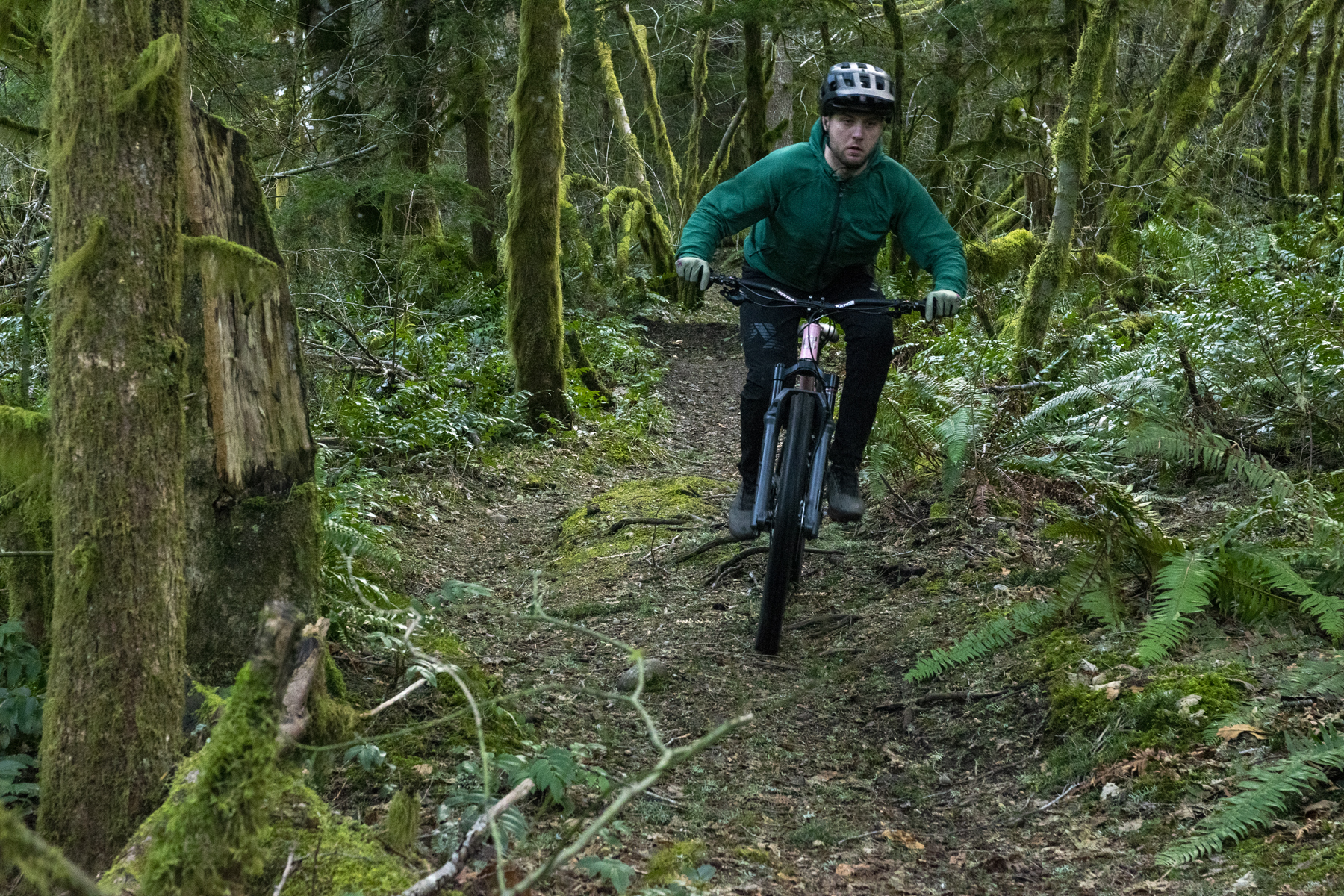
On the plus side, the smaller, separate pads do seem to wear more evenly than bigger, wider pads often do — especially on four-piston brakes with equally sized pistons. Typically the rear edge of the pad wears faster than the front since the movement of the rotor tends to draw the rear edge of the pad (i.e., the first part that a given cross-section of the rotor encounters as it rotates through) in and applies more force at that part of the surface; it’s common for brakes to put a larger piston in the forward position to counteract that effect. Despite their equally-sized pistons, the MT7s mitigate that effect by having smaller pads that don’t see as great a difference in force across their width.
But overall, the MT7s have been reliable and trouble-free in my time on them — and Magura offers a five-year warranty on them against leaking. They’ve been consistent, with no wandering bite point or other such issues, and once I got a good bleed on them after the initial installation, I haven’t needed to do anything other than replace worn-out pads.
Bottom Line
The Magura MT7 HC3s are a good option for riders who want a relatively powerful brake, but prioritize a short lever throw and firm bite point and are willing to forgo a little bit of outright power as compared to some of the latest crop of big, gravity-oriented brakes to get there. And while the HC3 lever is an especially good option for folks who prefer to run their levers in close to the bar, Magura has other options for riders with different preferences in terms of lever shape and feel.
To be clear, I do think the MT7s are still a DH-worthy brake for a lot of folks, but there are more powerful, fade-resistant options out there. The fiber-reinforced plastic lever body does feel a little flimsy and probably takes some extra care to not strip things, but it’s given me no real issues thus far, and to be fair, the MT7s are also notably light for this class of brake. They’re not without their quirks, but the MT7s work well and, in particular, offer a quite nice lever feel that it’s easy to imagine working well for a bunch of folks.

I ran MT7s for a couple years before going to Code RSCs and now Dominion A4s. David mentions a lot of the quirks inherent in the MT7, especially the pad alignment and rotor discoloration/heat management. The one other one I’d add is that it seems like the seal drag or system friction is relatively high, especially with the short HC3 lever. I did a couple rides on a bike with the Bruni levers, and those reduced the force needed due to the longer lever. The actual physical force required to pull the HC3 lever seems a bit higher (gut feeling 25% more) than a Code RSC, and much higher (gut feeling 50+%) than the Dominion A4. HC3 probably works best for people who stab their brakes as opposed to drag them.
Bless you, David Golay for these reviews. You offer detailed and relevant insights that we just don’t find in other publications. I built up a custom bike this past summer and went with the pretty conservative choice of SRAM Code RSC brakes because I’ve always found them to be solid and reliable performers. I even bumped up the performance recently with the newest HS2 rotors and Galfer Pro pads based on your reviews. With my next bike, I might be keen to try one of these other brakes like TRP, Hayes, Hope, etc..
Hey Brice, thanks for the kind words, and glad that you’re finding the reviews helpful!
Always Leakin’, always creakin’ …if ever just Shigura, if you wanna Set and forget bout anything brakes go with saint (paired with dächle HD discs and he orange Power pads from trickstuff…)… wanna have more Boutique german bling bling that sits in a League of its own…Trickstuff brakes